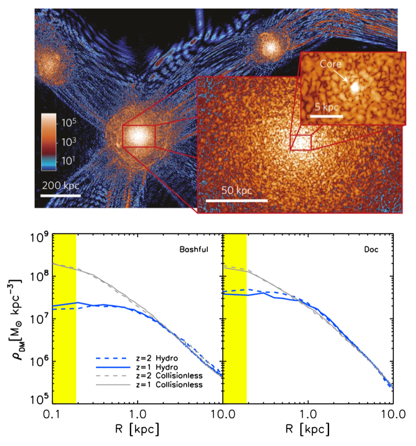How galaxies form and evolve is one of the fundamental questions in cosmology. In the standard ΛCDM model, the mass of the Universe is dominated by cold dark matter (CDM) which only interacts with normal particles (i.e. baryons) gravitationally. Although ΛCDM predicts accurately the distribution of mass at cosmological scales, at galactic scales, numerical simulations with only CDM fail to reproduce many properties of observed galaxies, including the abundance of satellites near Milky Way-mass galaxies, and the structural properties of dark matter in dwarf galaxies.
Many alternative dark matter candidates have been proposed to alleviate these discrepancies, and one appealing candidate is the Fuzzy Dark Matter model (FDM), which is shown to suppress small-scale structures due to the quantum nature of the scalar field. On the other hand, astrophysical processes associated with baryonic matters, in particular energetic feedback from supernova and supermassive black holes, can also have profound impact on galaxy abundances and dark matter structures.
The aim of this project is to understand the interplay between baryonic physics and dark matter models self consistently through galaxy formation simulations with both FDM and astrophysical models, in order to provide robust predictions for observations, and unveil the nature of dark matter.
Requirements
- MSc in astronomy, physics or computational science.
Supervisors
Associate Professor Sijing Shen
Associate Professor Claudia Cicone
Call 1: Project start autumn 2021
This project is in call 1, starting autumn 2021. Read about how to apply
